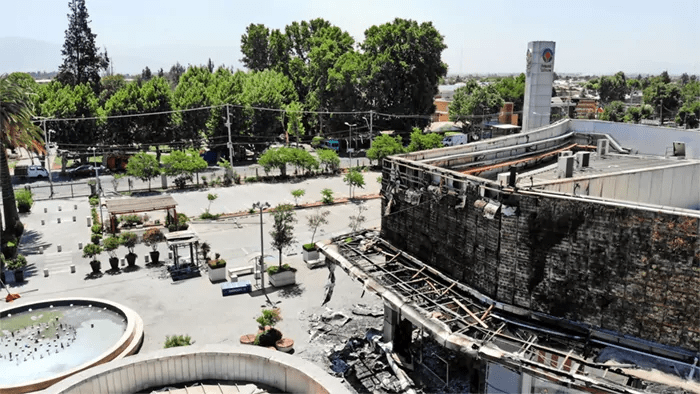Shops in malls see a drop in sales in 27% during the seven weeks leading to the crisis social: the second week plummeted 75%
The Mercury / December 1, 2019
In the second week of the conflict, the area most affected was the area south of the Metropolitan Region, with a drop in sales of 97%. In general, for items of products, the category of handbags, purses, backpacks and handbags is the most affected during the whole period, with a decline in sales of 47%.

The area north of the Metropolitan Region, saw a fall in 78% of their sales during the second week of the social explosion. There were affected malls in communes as Quilicura.
The seven weeks that is completing the social eruption have been impacted in different dimensions the activity of the country. The trade is one of them, and within that category, the shops housed in the shopping centers have been particularly affected.
From the start of the mobilizations and until this Thursday, the sales of shops that are located in these venues fell 27% at the national level, over the same period of the previous year, according to figures of FollowUP, a company that specializes in the management of the consumer's experience in retail, that collects the data of 1,900 stores that operate inside of shopping centers, excluding the format department.
The category of handbags, purses, backpacks and handbags are the most affected during this period, with a decline of 47% in sales. Follow costumes youth and adult man with a 42% in both cases, and of women, with 39%. A little further back, with a low of 29% from the shops of sportswear, with 27% of outdoor and 26% of the shoe, while the shops in the category children are the least affected, with a decline of 15% in the weeks analyzed.
Variation in total sales at the national level by week
In terms of the visits, the reverse is 28%, which implies that the inflow to the malls at the national level fell from 15.7 million a year ago to 11.3 million visits between October 19 and Thursday, November 28th.
For areas, the center of the Metropolitan Region exhibits the sharpest decline in sales, with a 48 per cent, which according to the CEO of FollowUP, Christian Cafatti, responds not only to the closure of premises in the wake of damage or looting, but the lowest flow of people, as a result of the abuses that have accompanied the demonstrations, a situation that is replicated at the national level.
Valparaiso is a city that presents the downfall in a more significant sales, with a 61%. This implies that the collection between October 19 and November 28, newly passed was $98.2 million, compared to the nearly $250 million that the shopping malls had in that area in the same period of last year.
In Concepción and Antofagasta, regional capitals, where there have also been attacks on the trade, the sales were reduced by 49% and 32%, respectively.
In respect of the involvement by heading to the shops, the reports received by FollowUP show that the footwear shops are the most affected by the looting, while the products of the home have been less exposed. The key factor in this case, explains the country manager of the company, Michelle Schnitzer, is the ease to reduce the goods stolen. Something similar happens with the category of accessories, such as purses, backpacks and handbags.
The week of the agreement the constitution was the only one that showed an uptick in sales 3%
In the detail of what have been these seven weeks, it was observed that the greatest impact until now was recorded during the second week of the protests, that is to say, between Monday 21st and Sunday the 27th of October, when sales at the country level sank 75%, with the area south of the Metropolitan Region as the most affected, with a decline of 97%, followed by the center of the capital, with 89%.
In the judgment of Cafatti, hardly the sales could reach a level lower than that of that week, because people will continue to buy, and even if an alternative could be the e-commerce, as a result of this situation the companies are also having trouble logistical important to meet with the deliveries, which leaves space for physical purchases.
In keeping with the evolution of this crisis, between days 11 to 17 of November, that is to say, the fifth week of this conflict is the only one that showed an increase in sales over the same period of the previous year, with a 3%, coinciding with the announcement of the agreement constituent, which occurred in the early morning of 15 November. The following week, however, when it became evident in an escalation of the violence and the attacks to shopping centers, sales resumed falls, reaching a 15%, a percentage that remained this week, with data collected up to the end of the day Thursday.
Following the trend of a year weak for retail in general, the prices of the products also have been influenced by this contingency. If in the first nine months to September showed a reduction of 2% from the same period of the previous year, in what will run out of this crisis the prices are 15% below the average observed in the same period of the previous year.
People are not going window shopping, going to the mall with a specific intention of purchase, and that translates into an increase of the rate of conversion to sales, which traditionally moves around 11% and is now in a range of 15%. That is to say, that 15% of the people that are coming to the stores purchase”.
Michelle Schnitzer
The Country Manager of FollowUP
In the detail of what have been these seven weeks, it was observed that the greatest impact until now was recorded during the second week of the protests, that is to say, between Monday 21st and Sunday the 27th of October, when sales at the country level sank 75%, with the area south of the Metropolitan Region as the most affected, with a decline of 97%, followed by the center of the capital, with 89%.
In the judgment of Cafatti, hardly the sales could reach a level lower than that of that week, because people will continue to buy, and even if an alternative could be the e-commerce, as a result of this situation the companies are also having trouble logistical important to meet with the deliveries, which leaves space for physical purchases.
In keeping with the evolution of this crisis, between days 11 to 17 of November, that is to say, the fifth week of this conflict is the only one that showed an increase in sales over the same period of the previous year, with a 3%, coinciding with the announcement of the agreement constituent, which occurred in the early morning of 15 November. The following week, however, when it became evident in an escalation of the violence and the attacks to shopping centers, sales resumed falls, reaching a 15%, a percentage that remained this week, with data collected up to the end of the day Thursday.
Following the trend of a year weak for retail in general, the prices of the products also have been influenced by this contingency. If in the first nine months to September showed a reduction of 2% from the same period of the previous year, in what will run out of this crisis the prices are 15% below the average observed in the same period of the previous year.
“Practically all of the weeks of this year, the shopping centers had promotions or sales,” says Cafatti, who projected that this trend should be maintained, as retailers face an increase in their stocks, because calculated from assumptions of flow and demand that this year did not materialize.
The data of FollowUP also realize a change in the habits of the consumers from the new conditions and schedules further reduced with the operating shopping centers. In the first place, the visits are concentrating on the weekends, the time spent in the shops has been reduced and there is an intent to purchase more. “People are not going window shopping, going to the mall with an intent to purchase specific, and that translates into an increase of the rate of conversion to sales, which traditionally moves around 11% and is now in a range of 15%. That is to say, that 15% of the people that are coming to the stores buying” says Schnitzer.
Another element that has changed is the time in which are concentrated the sale, as if before the outbreak of the 50% occurred between 17:00 and 21:00 hours, that percentage is now moved to the morning between 10:00 and 14:00 hours.













